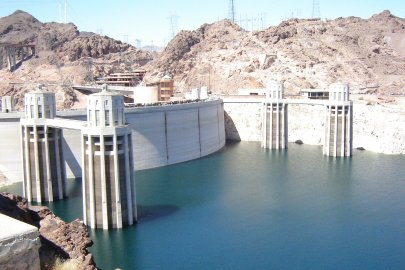An Archimedes Hydrodynamic Screw turbine, using composite materials and advanced manufacturing methods, is reducing costs and improving efficiency.
Water Power Technologies Office
January 13, 2021In July 2019, Percheron Power, with support from PNNL and Utah State University’s Water Research Lab, developed and tested a next-generation Archimedes hydrodynamic screw turbine constructed from composite materials and leveraging advanced manufacturing methods. While the Archimedes screw has been primarily used as an irrigation tool for several millennia, the past 15 years have seen exciting new applications of the device in the form of hydroelectric power. The project explored a new approach to manufacturing with potential to lower costs and increase efficiencies of future turbine blade development across the industry and demonstrated record efficiency for an Archimedes hydrodynamic screw turbine to date.
Though reliable, efficient, and fish-friendly, the technology has faced barriers to production, transportation, and installation that have resulted in higher project costs and slowed industry adoption of the design in the United States. The current Archimedes hydrodynamic screw manufacturing process requires bending of large steel plates that must be welded together, ground smooth and prepped for painting, then completely finished at a factory. This means a turbine assembly up to 16 feet in diameter and up to 80 feet long must be shipped fully constructed to the installation site, which is both costly and logistically challenging. Producing the turbines from composite materials, however, offers an attractive alternative on several fronts. The research team evaluated four optimized composite turbine designs developed and 3D printed by Percheron Power. The researchers generated more than 900 data sets and published a paper in the Journal of Hydraulic Engineering before selecting the best design for a larger prototype.
In Phase 1 of the project, researchers investigated various methods of blade fabrication before deciding upon Light Resin Transfer Molding, which offers lower production costs, as well as reduced waste and emissions relative to conventional steel. Though they can provide the same structural properties as steel, composite turbines are 25%‒30% lighter in weight. Because the composite blades are gel-coated while in the mold, they require no primer or corrosion-resistant paints as a steel blade would. Moreover, the smooth, gel-coated blades reduce corrosion—as well as friction—which reduces hydraulic losses.
Light Resin Transfer Molding produces identical, highly reproducible blades from molds that can be used more than 1,000 times each, ultimately resulting in reduced production costs per each turbine. Turbines produced through this method also eliminate oversize shipping costs and logistics, as the blades can be mounted on the shaft at the turbine installation site instead of the factory. The composite blades can be replaced individually, unlike a traditional steel turbine blade. The team also filed a patent on the design and methodology for producing this removable-blade turbine.
In Phase 2, the screw-turbine prototype was successfully tested at full scale. The Utah Water Research Lab completed more than 70 successful water test runs of the first prototype, achieving the highest measured efficiency of any Archimedes hydrodynamic screw to date, with power outputs of 39 kW, tested flows from 10 to 50 cubic feet per second, and turbine speeds from 10 to 40 revolutions per minute. The Composite Archimedes Hydrodynamic Screw Project effectively developed a new, optimized composite Archimedes hydrodynamic turbine, demonstrating it can be effectively and efficiently produced via advanced manufacturing methods. Percheron Power is believed to be the first company in the world to manufacture replaceable composite blades for an Archimedes hydrodynamic screw turbine or pump employing the Light Resin Transfer Molding process. The resulting composite blade turbines are durable, efficient, and cost-effective energy generators that are expected to positively impact future turbine assemblies and low-head hydropower applications.
For additional information, contact Sharon Atkin.
The Water Power Technologies Office e-newsletter brings funding opportunities, events, publications, and activities directly to your inbox.


